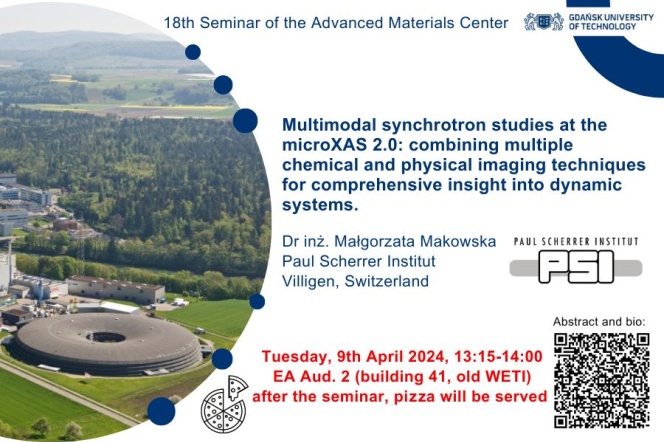Data dodania: 2024-03-27
18. Seminarium Centrum Materiałów Przyszłości

Osiemnaste seminarium Centrum Materiałów Przyszłości odbędzie się 9 kwietnia 2024 r. o godz. 13.15 w EA Aud. 2 WETI A (budynek 41). Dr Małgorzata Grażyna Makowska z Paul Scherrer Institut (Szwajcaria) wygłosi wykład pt. "Multimodal synchrotron studies at the microXAS 2.0: combining multiple chemical and physical imaging techniques for comprehensive insight into dynamic systems.". Po seminarium zapraszamy na pizzę.
Abstrakt:
Until October 2023, the microXAS beamline of the Swiss Light Source (SLS) stood out for its flexibility in conducting experiments employing a wide array of techniques, including 2D and 3D imaging with X-ray diffraction- and spectroscopy- contrast. This flexibility extended to parameters such as X-ray beam energy and size and aimed for high adaptability in accommodating various sample environments for operando studies across a wide temporal resolution range. For instance, experiments combining scanning micro-XRD and micro-XRF imaging with local micro-XAS analysis were performed on a daily basis. In the last years, due to the recent detection system advancements, significant experimental time was dedicated for operando XRD studies of dynamic processes such as laser advanced manufacturing, which was performed with acquisition rate up to 40kHZ. Operando XRD measurements were often combined with chemical imaging.
The ongoing upgrade of the Swiss Light Source and the introduction of a new X-ray undulator source, alongside new optics, will significantly alter the X-ray beam characteristics of the new microXAS 2.0 beamline. This enhancement will lead to increased flux, enlarged energy range, and improved dynamic focusing capabilities, unlocking new and unique scientific studies of materials and phenomena previously beyond reach. A unique, dynamic transition between pink and monochromatic beams, as well as focused and unfocused beams, will become more readily accessible. This will enable the combination of fast full field imaging with scanning methods within a single experiment. However, to fully harness these novel advancements, the experimental station of the beamline itself requires redesign. I will present examples of studies performed at microXAS before the upgrade as well as the new capabilities of microXAS 2.0 and our plans how to maximally exploit these new capabilities.
BIO:
Małgorzata Makowska graduated from Gdansk University of Technology in Applied Physics. She finished her PhD at the Department of Energy Conversion and Storage of Technical University of Denmark in collaboration with European Spallation Source (ESS ERIC) in 2015. In years 2016-2018 she worked as an instrument scientist at the fast neutron imaging beamline NECTAR at FRM II, Heinz Maier-Leibnitz Zentrum (MLZ) (Garching, Germany). From 2018 to 2021 she was engaged as a postdoctoral fellow in the group Photons for Engineering and Manufacturing (PEM) at PSI. During this time she worked on advanced manufacturing of ceramics using various synchrotron characterization techniques, such as XRD, XRF- contrast imaging, full field tomographic microscopy and high resolution powder diffraction. In April 2021 Małgorzata started a bridge position between two divisions of PSI : NES (Nuclear Energy and Safety) and PSD (Photon Science Division). She is enrolled in two groups: as a material scientist in Advanced Nuclear Materials group and as a beamline scientist in the microXAS group.

